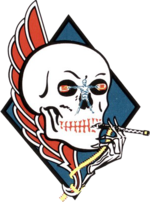VA-34 (1943-69)
| Attack Squadron 34 | |
|---|---|

VA-34 squadron insignia
|
|
| Active | 15 October 1943 – 1 June 1969 |
| Country | United States |
| Branch | United States Navy |
| Role | Attack aircraft |
| Part of | Inactive |
| Nickname(s) | Blue Blasters |
| Engagements |
World War II Vietnam War |
| Aircraft flown | |
| Attack |
F6F-3/5 Hellcat F8F-1/2 Bearcat F9F-2 Panther F2H-2 Banshee F7U-3 Cutlass A4D-1/2/C Skyhawk |
VA-34, nicknamed the Blue Blasters, was an Attack Squadron of the U.S. Navy. The squadron was established as Fighter Squadron VF-20 on 15 October 1943, redesignated as VF-9A on 15 November 1946, as VF-91 on 12 August 1948, and as VF-34 on 15 February 1950. It was finally redesignated VA-34 on 1 July 1955. The squadron was disestablished on 1 June 1969. It was the second squadron to bear the VA-34 designation, the first one having been renamed VA-35 in 1950.
The squadron’s first insignia was approved for use by VF-20 during World War II, and was a "Joker" breaking out of a deck of cards carrying a machine gun. This insignia was selected by the squadron because the young and inexperienced pilots in the squadron were referred to as the "Jokers". It was approved by Chief of Naval Operations on 15 March 1944. The next insignia adopted by the squadron was the outline of a human skull, approved by CNO on 1 February 1946. Superimposed on the nose of a skull was a human skeleton with the arms holding paddles that became the eyes of the skull, while the teeth were represented by the word “Fighting 20.” On 10 June 1949, CNO approved another modification to the squadron insignia which embellished the skull design. This insignia was in use from 1949 until the squadron’s disestablishment in 1969. In 1957 the squadron adopted the Blue Blasters nickname, taking inspiration from their blue tail colors and their nuclear weapon delivery capability; hence the name "Blue Blasters."
VF-20 "Jokers" was established on 15 October 1943 as part of Air Group 20 stationed at NAS San Diego, California. The squadron was composed of numerous newly winged Naval Aviators along with a few combat veterans. On 16 April 1944 the squadron departed NAS Alameda aboard USS Essex en route to Hawaii for four months of operational training prior to its first combat tour.
On 31 August 1944, the squadron’s first combat action came as combat strikes were flown from USS Enterprise (CV-6) in squadron F6F Hellcats against the Bonin Islands. Strikes followed to Yap and Palau Islands, Peleliu Island, Okinawa, Formosa, Luzon, and Leyte. VF-20 was heavily involved in the initial invasion operations in the Philippines, including the epic Battle of Leyte Gulf from 24–25 October 1944. VF-20 aircraft struck elements of all three Japanese Task Forces which were converging on Leyte Gulf.
...
Wikipedia
